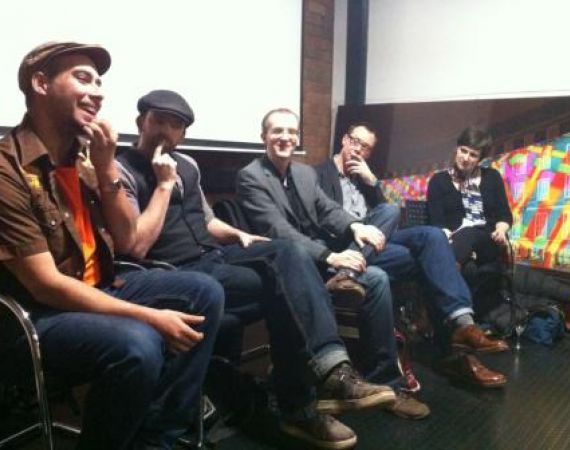Posted on Thu 26 Jan 2012
The Beauty of Digital: New technologies, old aesthetics and where the two meet
On Wednesday night the Pervasive Media Studio and Creative Times joined forces to present an event looking at how the visual languages of the past intertwine with the new technologies that shape our everyday lives.

Posted by
On Wednesday night the Pervasive Media Studio and Creative Times joined forces to present an event looking at how the visual languages of the past intertwine with the new technologies that shape our everyday lives.
This event was introduced by Chris Sharratt, Editor of creativetimes.co.uk, and chaired by Clare Reddington, Director, iShed and Pervasive Media Studio. We were joined by an inspiring panel of local digital creatives:
(Image: left to right)
- Simon Johnson of SlingShot, creators of street and pervasive games
- David McGoran, Roboticist, Puppeteer, Toy maker, Dancer, Creative Technologist
- Baldur Bjarnason, expert on eBooks and interactivity
- Jonathan Waring, Creative Director, 3Sixty digital design agency
Each panelist presented their take on the Beauty of Digital and then the discussion opened out to the panel and to the audience.
Amongst the topics explored was false the notion of a fixed 'old aesthetic'. Even with literary publishing, often fetishised as an aesthetic to be preserved, the form has moved from constant iterative revisions to the recent trend for finite finished products at the point of publication; and from blank dust covers that you would have to cut to get to the pages, to a tightly bound cover, often designed in isolation from the author.
Jonathan Waring warned against using the immediacy afforded by modern design tools to rush content to market early without being considerate of the craft of making. He advocated taking time to choose typography carefully as the typesetters of a pre-digital age were required to do. The group discussed the new 2.0 dynamic where everyone is a potential publisher and ideas can be tested and explored collaboratively and in public without having the polish of aestheitc rigour applied.
We talked about using deeply embedded cultural genres that draw on historical aesthetics such as Victoriana, steam punk or even zombies and vampires as a way of giving audiences a shortcut to a relationship with new formats, be that in pervasive games, robotics or mobile and PC interfaces. It was suggested that one of the reasons that Apple operating systems, with all its nods to old aesthetics and an unashamed use of nostalgic imagery, is more popular than Microsoft's stripped back, modernist, grid-based approach to Windows mobile and upcoming Windows 8 operating system, in that it offers users a collective frame of reference to call on when making meaning with digital products.
To join the debate please leave your comments below and for more info read Chris Sharratt's blog on Creative Times.
